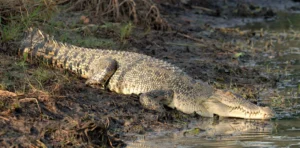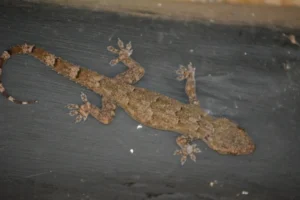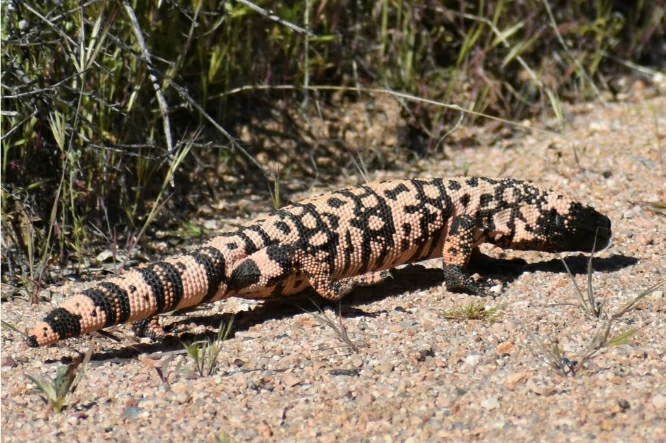If you’ve ever watched a lizard crawl across a wall or peek up from a warm rock, it’s easy to see why people thought dragons were real.
They’ve got scaly bodies, flicking tongues, and eyes that look way smarter than you’d expect. Some puff up, hiss, or flare a frill like something out of a story. So it makes you wonder: are lizards actually related to dragons?
No, lizards aren’t directly related to dragons because dragons don’t exist as real animals. But the idea of dragons came from real animals like lizards, crocodiles, and snakes. People just mixed what they saw and made it bigger and scarier in stories: sharp claws, scaly skin, even fire-breathing tempers.
Even though dragons don’t exist, lizards were definitely part of the inspiration. When you start looking closely, you can see how much real life shaped the myth.
Why People Thought Lizards Were Like Dragons
A long time ago, people didn’t have microscopes or DNA tests. They explained nature with what they could see, and what they could imagine.
Seeing big monitor lizards or crocodiles probably felt exciting and scary at the same time. These animals looked old and powerful, nothing like anything else around.

Big lizards like the Komodo dragon made that idea even stronger. This giant from Indonesia can grow over 10 feet long and has a bite strong enough to take down a deer.
Its name “dragon” stuck for a reason. Villagers told stories about it as a monster that could kill with one bite.
Later, scientists found that Komodo saliva actually has venom that slows its prey. So the stories weren’t that far off.
Smaller lizards added to the mystery too. Frilled lizards from Australia open a huge collar around their neck when they feel threatened, making them look like tiny dragons.
Bearded dragons, which people keep as pets, have spiky scales under their chin that puff up when they’re excited or angry.
So even though dragons never really walked the earth, lizards have been acting like them for centuries.
What Lizards Really Are
.Lizards are reptiles, which also include snakes, turtles, and crocodiles. Their family tree goes back over 300 million years, to when reptiles split from amphibians.
Lizards are part of a group called Squamata, which also includes snakes and worm lizards. That means lizards are closer to snakes than to crocodiles, or dragons.

They share traits like scaly skin, cold-blooded bodies, and the ability to shed their skin as they grow.
You can even see it in their bones and DNA. Some lizards, like skinks, lost their legs completely, turning into snake-like shapes.
Basically, lizards are real examples of how ancient reptiles kept changing and adapting, while myths stayed the same.
How Dragons Probably Came From Real Reptiles
When people found old bones or fossils, they had no idea what they were looking at. Some thought they were monsters. Others thought they were proof dragons once lived.
Think about it. If you found a dinosaur skull without knowing dinosaurs existed, huge teeth, eye sockets, and a long jaw would look just like a dragon’s head.
Some historians think Chinese farmers who dug up dinosaur fossils were the first to start telling dragon stories thousands of years ago.
Later, explorers saw real animals that matched those stories. Crocodiles in the Nile, giant lizards on tropical islands, snakes longer than a person; each sighting made the stories feel more real.
Even today, you can see the link. The Komodo dragon, named in 1912, is a real animal that probably inspired a lot of fire-breathing monster stories.
The Draco lizard, a small tree-dweller from Southeast Asia, can glide through the air using flaps of skin that look like wings. It doesn’t breathe fire, but it really does “fly,” so it’s easy to see how imagination did the rest.
What About “Dragon Lizards” and Their Names?
It’s funny how many lizards have “dragon” in their names. You’ve got:
-
Komodo dragon (the biggest living lizard)
-
Bearded dragon (a small spiky lizard kept as a pet)
-
Flying dragon or Draco lizard (a tiny gliding lizard from Asia)
None of these are mythical. They got their names because they look or act like dragons.
The Komodo’s size and strength earned it the name. The bearded dragon’s spines and beard-like throat make it sound fierce.
The Draco lizard’s wing-like flaps are so unusual that “dragon” almost feels like the only word that fits.
So when someone says “dragon,” they could be talking about something real or made-up, but in both cases, lizards are the spark.
Why Lizards Feel “Dragon-Like”
It’s not just looks. Lizards have traits that feel like the creatures legends were built around.
For example:
-
Scales. Both dragons and lizards are shown with overlapping scales. Lizard scales are made of keratin (the same stuff in your hair and nails) and help protect them.
-
Cold-blooded. Lizards rely on the sun for warmth. That’s why they bask on rocks like they’re guarding treasure. Dragons in stories do the same thing.
-
Claws and teeth. Lizards use them for climbing, gripping, and catching food. In myths, dragons use them for fighting, but that part came from real animals.
-
Head shapes. Many lizards have long, triangular heads that look like the classic dragon profile.
Behavior matters too. Lizards can be calm one minute and fierce the next. T
hey puff up, hiss, change colors, or flash bright displays; all things that feel dramatic and “dragon-like” to us.
Were Dinosaurs the Real “Dragons”?
Some scientists think dragons were inspired by dinosaur fossils too. That makes sense.
Dinosaurs were the dominant reptiles on Earth for over 160 million years, and their bones are found all over the world. People finding those huge bones would’ve seen the same features (scales, claws, long tails) that matched dragons in their stories.

For example, fossils of Theropods, like T. rex, look a lot like dragons painted in medieval Europe: walking on two legs, full of teeth, and scary.
Dinosaurs were real, dragons were what people imagined.
Lizards and dinosaurs are connected too. Lizards are part of the same big reptile family tree. They just took a different path and survived where dinosaurs didn’t.
Dragons in Culture and How Lizards Fit In
Dragons show up everywhere. From Asia to Europe to the Americas, almost every culture has them, and most share reptile traits.
In Chinese stories, dragons are wise and powerful, linked to rain and water. They’re long and snake-like, more like snakes or legless lizards than winged dragons.
In European stories, dragons are fierce, fire-breathing, often guarding treasure or princesses. They’re more like giant crocodiles with wings than snakes.
In Aztec culture, the god Quetzalcoatl the “feathered serpent”)was part bird, part reptile, blending real traits into something mythical.
All these stories started with people seeing real animals and letting their imagination fill in the rest. Lizards, snakes, crocodiles; they sparked dragon myths all over the world.
So, Are Lizards and Dragons Related?
Not really, if you mean by blood. But in terms of stories and inspiration? Absolutely. Dragons are humans’ way of taking the most interesting parts of reptiles and turning them into one creature.
- Lizards gave us the look; the scales, the eyes, the claws.
- Crocodiles gave us strength and jaws.
- Snakes gave us movement and mystery.
- Dinosaurs gave us the bones that proved something powerful once ruled the world.
Even though dragons don’t exist, they’re made from pieces of real life.
Every time you see a bearded dragon under a heat lamp, you’re looking at the closest thing nature ever made to a mythical dragon.
Conclusion
Lizards and dragons aren’t related by blood, but they’re connected by imagination. Humans looked at lizards (creatures that can shed their tails, change colors, puff up, and move quickly) and saw something magical. Over time, that magic turned into the dragon myth.
So while dragons might only live in stories, their roots are alive in every lizard you see today.
From the fierce Komodo to the tiny gecko on your wall, these animals show that nature doesn’t need fire or wings to be incredible, it already is.
And maybe that’s the real truth behind the myth: dragons might not exist, but they were never far from reality to start with.
Hi, my name is Ezra Mushala, i have been interested animals all my life. I am the main author and editor here at snakeinformer.com.

